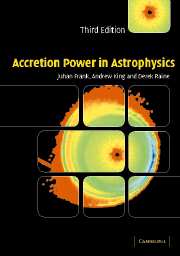Book contents
- Frontmatter
- Contents
- Preface to the first edition
- Preface to the second edition
- Preface to the third edition
- 1 ACCRETION AS A SOURCE OF ENERGY
- 2 GAS DYNAMICS
- 3 PLASMA CONCEPTS
- 4 ACCRETION IN BINARY SYSTEMS
- 5 ACCRETION DISCS
- 6 ACCRETION ON TO A COMPACT OBJECT
- 7 ACTIVE GALACTIC NUCLEI
- 8 ACCRETION DISCS IN ACTIVE GALACTIC NUCLEI
- 9 ACCRETION POWER IN ACTIVE GALACTIC NUCLEI
- 10 THICK DISCS
- 11 ACCRETION FLOWS
- Appendix: Radiation processes
- Problems
- Bibliography
- Index
11 - ACCRETION FLOWS
Published online by Cambridge University Press: 05 June 2012
- Frontmatter
- Contents
- Preface to the first edition
- Preface to the second edition
- Preface to the third edition
- 1 ACCRETION AS A SOURCE OF ENERGY
- 2 GAS DYNAMICS
- 3 PLASMA CONCEPTS
- 4 ACCRETION IN BINARY SYSTEMS
- 5 ACCRETION DISCS
- 6 ACCRETION ON TO A COMPACT OBJECT
- 7 ACTIVE GALACTIC NUCLEI
- 8 ACCRETION DISCS IN ACTIVE GALACTIC NUCLEI
- 9 ACCRETION POWER IN ACTIVE GALACTIC NUCLEI
- 10 THICK DISCS
- 11 ACCRETION FLOWS
- Appendix: Radiation processes
- Problems
- Bibliography
- Index
Summary
Introduction
We have seen in the foregoing chapters that a huge variety of accretion flows are at least theoretically possible. The equations describing axially symmetric flows with gravity, pressure and rotation allow a wide array of solutions of astrophysical interest. If one includes Ω = 0 (no rotation) as a special case, then even ordinary stars and spherically symmetrical Bondi accretion are solutions. More realistically, accretion flows with low angular momentum may produce supersonic flows which shock at smaller radii if they lack pressure support, or produce settling, cooling solutions if partially supported by pressure. We have already studied in detail spherically symmetrical accretion, the standard thin disc, and thick discs, and we will study other solutions which have acquired recognition in the astrophysical literature, such as slim discs and advection dominated accretion flows (ADAFs). In this chapter we shall attempt to organize all the different solutions into a coherent picture in order to clarify their relation to each other.
The fact that black holes possess an event horizon instead of a hard surface makes the inner boundary condition for black hole accretion flows qualitatively different from that for a normal star, and allows the existence of a family of solutions in which a significant fraction of the dissipated energy is advected through the horizon. Hence, for an external distant observer, ADAFs on to black holes are characterized by a low radiative efficiency η. (In ADAFs on to objects with a hard surface the advected energy must be ultimately reprocessed and released near the surface – see Section 11.8.3.)
- Type
- Chapter
- Information
- Accretion Power in Astrophysics , pp. 319 - 344Publisher: Cambridge University PressPrint publication year: 2002



